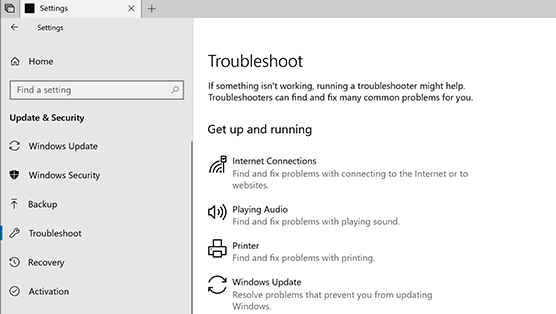In Windows 11, taking control of your device's updates is crucial for maintaining optimal performance and security. This guide is designed to address your questions and troubleshoot common issues that may arise during the Windows 11 update process.
Managing Windows 11 Activation
If you're seeking information on Windows 11 activation or verifying your installation, refer to our guide on Active windows 11.
Instead of relying on fix-it tools, Windows 10 utilizes troubleshooters to assist you in resolving issues with your computer. To initiate a troubleshooter, follow these steps:
Click on the Start menu.
Choose Settings.
Select Update & Security.
Navigate to Troubleshoot.
Click on Additional troubleshooters.
Alternatively, you can quickly access troubleshooters by using the Find troubleshooters shortcut located at the end of this topic, and then choose Additional troubleshooters
 |
Troubleshoot problems updating Windows |
Troubleshooting Update Installation
Encountering difficulties with Windows updates? Explore the following tips to identify and resolve issues affecting your device:
1. Administrative Access
Ensure your account has administrator privileges. If not, create a local user or administrator account in Windows or seek assistance from someone with administrative access.
Important: Before proceeding, back up your personal files to prevent data loss.
2. Free Up Drive Space
Make sure your device has sufficient space (at least 16 GB for 32-bit OS or 20 GB for 64-bit OS). If storage is limited, consider using a USB drive.
3. Restart Your Device
Many updates require a device restart. Save your work, close applications, and initiate the restart through Start > Power.
4. Run Windows Update
After completing the above steps, run Windows Update again via Start > Settings > Windows Update > Check for updates. Download and install any pending updates.
5. Disconnect External Hardware
Temporarily remove unnecessary external devices and hardware. Then attempt to run updates again.
6. Update Third-Party Drivers
Check for updates on the hardware manufacturer's website if you've added new hardware to your device. Update drivers and retry the update process.
7. Check Device Manager
Scan Device Manager for errors. Address any issues by updating or uninstalling problematic devices.
Common Update Issues
If you encounter error codes or face installation stalls at specific percentages, utilize the Windows Update Troubleshooter and explore additional solutions in our guide on [Fixing Windows Update Errors](insert link).
Managing Update Notifications
Learn how to pause updates temporarily and schedule restarts at your convenience. Note that notifications only appear when a restart is necessary.
Data Usage and Update Impact
Understand the minimal data impact of monthly quality updates and occasional feature updates. Control installation on metered connections.
Enhancing PC Performance
Discover tips on improving your computer's speed with the latest Windows 11 version in our guide on [Enhancing PC Performance in Windows](insert link).
Post-Update Issues
If you face challenges locating files post-update, consult our guide on [Finding Lost Files after Windows 10 or 11 Upgrade](insert link).
Advanced Troubleshooting (For Advanced Users)
For experienced users comfortable with the command line, explore advanced procedures like renaming software distribution folders, temporarily removing third-party security software, repairing hard drive errors, performing a clean restart, restoring and repairing system files, and even considering a clean installation of Windows 11.
Note: Advanced procedures require administrator permissions. Always exercise caution and back up your data before attempting these steps.
For additional support or feedback, use the Windows Update Troubleshooter, Get Help, or the Feedback Hub.
Remember: Windows 11 is designed to be the most secure version, and regular updates are recommended for optimal performance and security. While updates can be paused temporarily, staying current is essential for a smooth-running PC.




